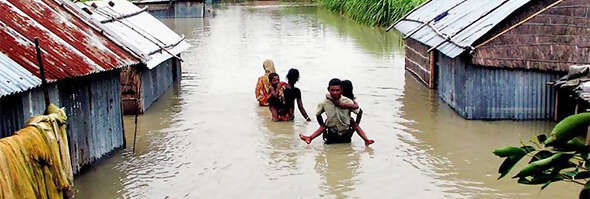CLIMATE CHANGE A CHALLENGE
Posted on 12/10/2015

The future will be a watery one for some of the world's biggest cities faced with the challenge of adapting to climate change, and rising sea levels. Predicted sea level increases this century mean many cities face increased flooding, stronger storm surges and unpredictable weather. How well coastal cities can cope will dramatically affect quality of life and their economic destiny.
Many of the biggest are in Asia, powering economies while housing hundreds of millions of poor in sprawling slums.
Scientists generally agree seas will rise an average of 1 metre (3 feet) this century, though some predict an eventual increase as high as 6 metres on average. How quickly these changes occur will partly depend on whether negotiators at this week's UN climate talks in Paris can broker a strong treaty to limit the release of climate-warming greenhouse gases.
But with a certain amount of sea rise considered inevitable as warmer temperatures melt glaciers and expand oceans, cities will have to adapt quickly to spare investors losses and citizens from disaster. Those unprepared risk being highlighted as poor places to invest.
“It's difficult for businesses and societies to grasp what's happening,” said Richard Hewston, a climate change analyst at Verisk Maplecroft, which advises companies on business risks. But some governments now realize “they need to pay attention to these climate risk factors to attract investment.”
Global losses from flooding in coastal cities are already averaging about US $6 billion a year, according to a 2013 study published in the journal Nature. Those losses could rise to $52 billion annually by 2050, it said.
Asia is particularly vulnerable because many of its countries are still struggling to lift hundreds of millions up from poverty, while its cities attract droves of migrants seeking better economic opportunities. Within a decade the world is expected to have 37 megacities with populations over 10 million, and 21 of them will be in Asia.
The Bangladesh capital, Dhaka, holds sprawling slums to which millions fled when rising seas swallowed their coastal homes. India's finance capital Mumbai has an annual gross domestic product of about $151 billion, along with some 2.8 million people crammed into low-lying slums that flood regularly.
“There are many children, too, who live in these homes,” said Birender Bacchar Singh, who lives in Mumbai's Dharavi slum. “Sometimes when huge waves reach the houses and crash, the shacks collapse and all our belongings get washed away. Yet we have no option but to live here.”
But the economic contribution of these cities is crucial. Highly vulnerable Dhaka alone makes up more than half of Bangladesh's GDP of $150 billion. Frequently flooded Manila accounts for two-third of the Philippines' economy, while Shanghai's $594 billion GDP or Hong Kong's $416 billion are bigger than the economies of many nations.
